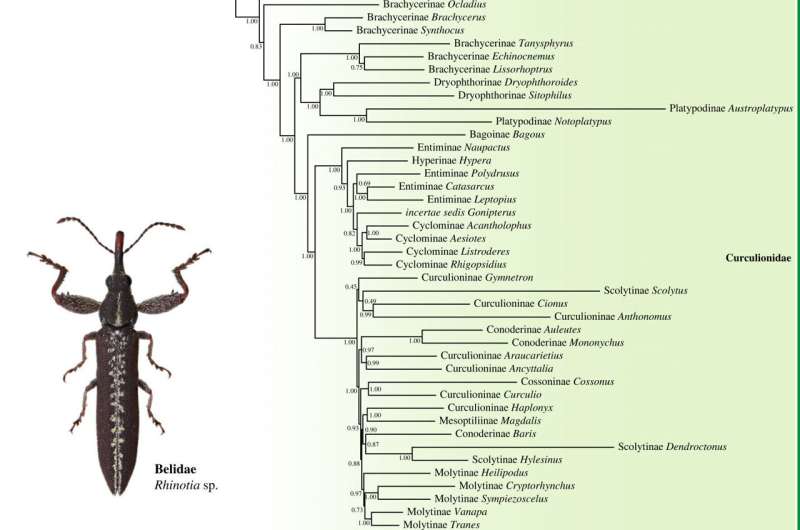This article has been reviewed according to Science X's editorial process and policies. Editors have highlighted the following attributes while ensuring the content's credibility:
fact-checked
peer-reviewed publication
trusted source
proofread
Researchers construct phylogenetic skeleton tree of weevils

Weevils (superfamily Curculionoidea) represent a hyperdiverse and globally distributed group of phytophagous beetles, with approximately 62,000 described species in 5,800 genera.
Recently, researchers led by Prof. Cai Chenyang from the Nanjing Institute of Geology and Paleontology of the Chinese Academy of Sciences (NIGPAS) have conducted a phylogenetic reanalysis of the previously published anchored hybrid enrichment datasets and solved the evolutionary relationships of extant weevil families.
The results were published in Biology Letters on Sept. 20.
The vast majority of weevils have a forward-facing rostrum that resembles an elephant's trunk. Weevils are divided into eight extant families: Cimberididae, Nemonychidae, Anthribidae, Belidae, Attelabidae, Caridae, Brentidae and Curculionidae.
The evolutionary relationships among the families are largely resolved, with the Attelabidae, Caridae, Brentidae, and Curculionidae constituting a monophyletic group (ACBC clade), while the Cimberididae, Nemonychidae, and Anthribidae are basal lineages. The systematic position of Belidae is somewhat controversial, and most studies based on morphological and molecular data generally consider it as the sister group of the ACBC clade.
However, a recent Anchored Hybrid Enrichment (AHE)-based phylogenomic study suggests that Belidae is sister to Nemonychidae and Anthribidae.
In the current study, under the supervision of Prof. Cai, Li Yanda, a doctoral student at the University of Bristol, in collaboration with colleagues from the American Museum of Natural History and the University of Bristol, compared different data filtering methods, different evolutionary models and different tree building strategies on the tree topology.
The researchers found that when appropriate data filtering was used to remove incorrectly aligned gene sequences, or when a more appropriate site-heterogeneity evolutionary model was taken, or the coalescent strategy was properly used, Belidae were always resolved as sister groups of the ACBC clade.
"This result is fully consistent with the phylogenetic relationship based on morphological evidence. We provide a consistent and robust backbone phylogeny of weevils," said Prof. Cai. "More importantly, our analyses emphasize the significance of data curation and modeling compositional heterogeneity of molecular data in today's phylogenomic studies."
More information: Yan-Da Li et al, Phylogenomics of weevils revisited: data curation and modelling compositional heterogeneity, Biology Letters (2023). DOI: 10.1098/rsbl.2023.0307
Journal information: Biology Letters
Provided by Chinese Academy of Sciences




















